 Illustrated by Matt Faulkner.
Illustrated by Matt Faulkner.
Little Brown for Young Readers.
In 1840, Elizabeth Cady Stanton, Lucretia Mott, and three other women ignited a movement for women’s rights that continues today. Matt Faulkner’s humorous illustrations combined with Doreen Rappaport’s engaging text provide a picture on the struggle for equal rights for women in this inspiring and often funny book.
Awards
Junior Literary Guild
School Library Journal, Best of 2016
Mighty Girls Empower Title
NCSS Notable Trade Books
Amelia Bloomer List
Reviews
“This lively yet forthright narrative pivots on a reality that should startle modern kids: women’s right to vote was only achieved in 1920, 72 years after Elizabeth Cady Stanton organized the first Women’s Rights Convention in Seneca Falls, New York. Indeed, time’s passage figures as a textual motif, connecting across decades such determined women as Stanton, Sojourner Truth, Susan B. Anthony, and Lucy Stone. Faulkner’s meticulously researched gouache-and-ink illustrations often infuse scenes with humor by playing with size and perspective. Rappaport makes this long struggle palpable and relevant, while Faulkner adds a winning mix of gravitas and high spirits.” Kirkus
“A lively look at the women’s suffrage movement… The eponymous Elizabeth Cady Stanton and her courageous cohorts (Susan B. Anthony, Lucy Stone, and Sojourner Truth) are presented with both imaginative flair and factual precision as they gather at the first Women’s Rights Convention in 1848 and work diligently and selflessly through the decades to bring about change. Matt Faulkner’s illustrations clearly depict the individuals and historical milieu while also injecting humor Quick mentions in both text and artwork of groundbreaking women including individuals who participated in the Civil War (as spies, nurses, and soldiers on both sides) and more-modern-day advocates (Mother Jones, Shirley Chisholm, Sonia Sotomayor, etc.) provide impetus for further investigation.” School Library Journal
“She couldn’t go to college. She couldn’t become a politician. She couldn’t even vote. But Elizabeth Cady Stanton didn’t let that stop her. She called on women across the nation to stand together and demand to be treated as equal to men-and that included the right to vote. With the help of these trailblazers’ own words, Doreen Rappaport’s engaging text, brought to life by Matt Faulkner’s vibrant illustrations, shows readers just how far this revolution has come, and inspires them to keep it going!” Bookshelf
“A solid introduction to Stanton and the women’s rights movement.” School Library Journal
“Though Elizabeth Cady Stanton is the titular character, this book provides a comprehensive primer on the struggle for female suffrage and equal political representation in the U.S. from the colonial period through the Nineteenth Amendment. . . the most compelling stories are the everyday anecdotes, such as Susan B. Anthony minding Stanton’s children while she penned speeches, Lucy Stone omitting the word obey from her wedding vows, and the first students at Mount Holyoke crowding around a table full of laboratory equipment. Faulkner’s illustrations capture the spirit of each character and of the movement itself, and primary source quotes from the likes of Sojourner Truth and Alice Paul drive home the importance of the events described.” Booklist
Excerpts
Visit the Women’s Rights National Historic Park in Seneca Falls, New York

The Women’s Rights National Historic Park has important buildings associated with the first woman’s rights convention. This is restored home of Thomas and Mary Ann M’Clintock where the five women planned that first meeting in 1848.
Photo courtesy of the Women’s Rights National Historic Park
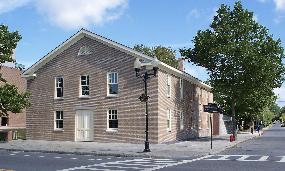
This is the Wesleyan Chapel where the women met for the First Women’s Rights Convention.
Photo courtesy of the Women’s Rights National Historic Park
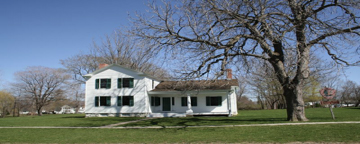
Elizabeth Cady Stanton’s home was at 32 Washington Street in Seneca Falls, NY, from 1847 to 1862. Four of her children were born here.
Photo courtesy of the Women’s Rights National Historic Park
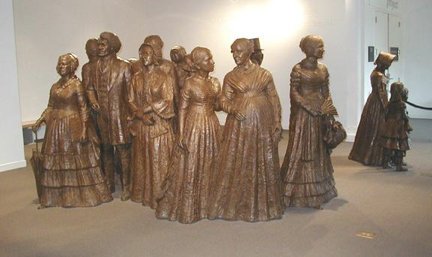
This statue, called “The First Wave” by sculptor Lloyd Lillieis is at the Women’s Rights National Historic Park. It depicts nine of the 300 men and women who were at the Convention. Eleven figures are not identified, because only one out of every three people present signed the Declaration.

Find out more about this complex gathering of figures.
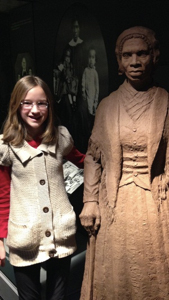
Mia Lazar and the Sojourner Truth statue.
Twelve-year-old Mia Lazar from Blacksburg, Virginia became interested in the woman’s rights movement when she portrayed Susan B. Anthony in a skit. She came to the Women’s Rights National Historical Park to discover more history about this In 2014 For National History Day, Mia created a video of her responses to what she saw. (You can make a video of your trip, too! )
Click below for her video.
PHOTO GALLERY
Matt Falkner looked at historical photos to create his own illustrations of these women trying to capture their energy and period dress. Here are photographs of some of the women he illustrated.
 Elizabeth Cady Stanton (1815-1902 ) with sons, Daniel and Henry, two of her seven children. |
 Lucretia Mott (1793 – 1880) was a troublemaker, too, and was one of the five women who organized the first convention and eagerly put her signature to the Declaration of Rights and Sentiments. |
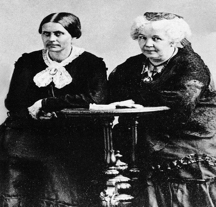 Elizabeth Cady Stanton on the right, and Susan B. Anthony, her colleague-in-arms is on the left. |

This is a copy of the Declaration of Sentiments of 1848.
Click here and read the actual text and see the names of the 68 women and 32 men who signed it on July 20, 1848.

Black men and women fought alongside whites for equality in 1848, too. Frederick Douglass and Sojourner Truth were famous for their eloquent and fiery speeches.
Click and read Truth’s full speech at the Woman’s Convention in Ohio.

Susan B. Anthony traveled across the United States and to Europe. She carried this red alligator purse and a red shawl with her everywhere she went. The purse was filled with important papers on which she wrote her speeches and ideas about how to change the world. It even had the transcript of her 1873 trial.
There’s a jump rope song that include Susan B. Anthony’s purse. Maybe you know it:
“Miss Lulu had a baby, she called him tiny Tim.
She put him in the bathtub,
To see if he could swim.
He drank up all the water!
He ate up all the soap!
He tried to swallow the bathtub,
but it wouldn’t go down his throat!!
Call for the doctor!
Call for the nurse!
Call for the lady with the alligator purse!
“Mumps!” said the doctor.
“Measles!” said the nurse.
“Vote!!” said the lady with the alligator purse!!
Click here and take an online tour of Susan B. Anthony’s House at 17 Madison Street in Rochester, NY. and learn lots more about this incredibly determined woman who helped change history.

SEE PHOTOS OF WOMEN WHO PARTICIPAGED IN THE CIVIL WAR

Belle Boyd, Confederate Spy

Phoebe Pember, Confederate Nurse

Rose Greenhow, Confederate Spy
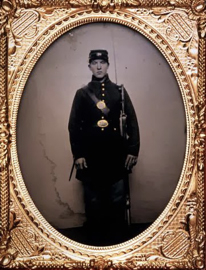
Sarah Wakeman, Union Soldier

Clara Barton,Union army nurse
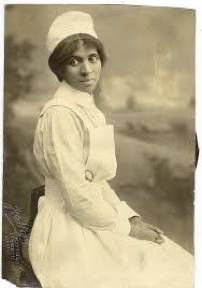
Susie King Taylor, Union Nurse

Loreta Velazquez, Confederate Soldier
Learn More
For photos of other suffragists, go here
Be present at the 1913 Suffrage Parade in Washington, DC.
This links to a site about the friendship of Susan B. and Elizabeth:
Click Here to Read
Return to Celebrating Women’s History
